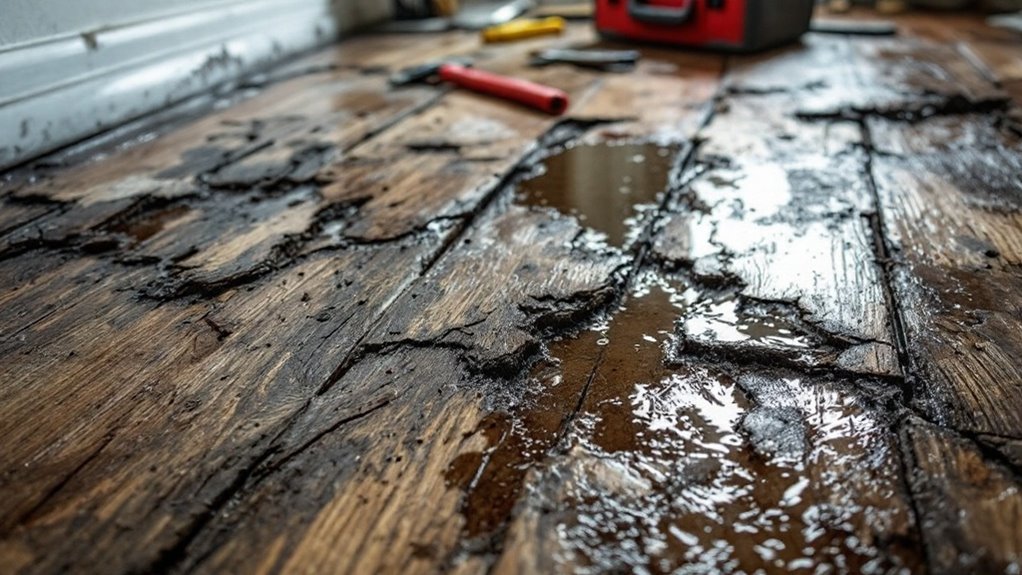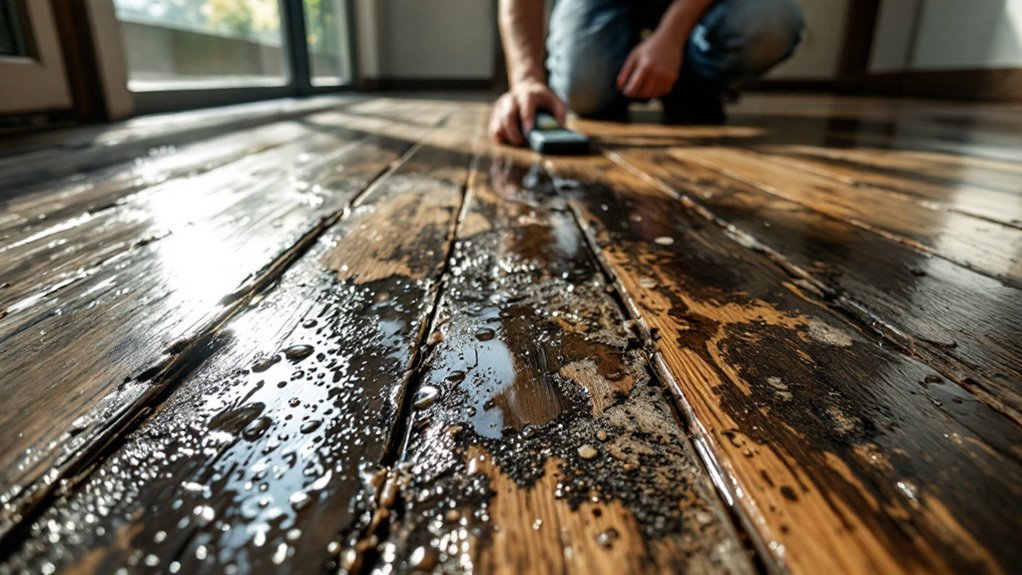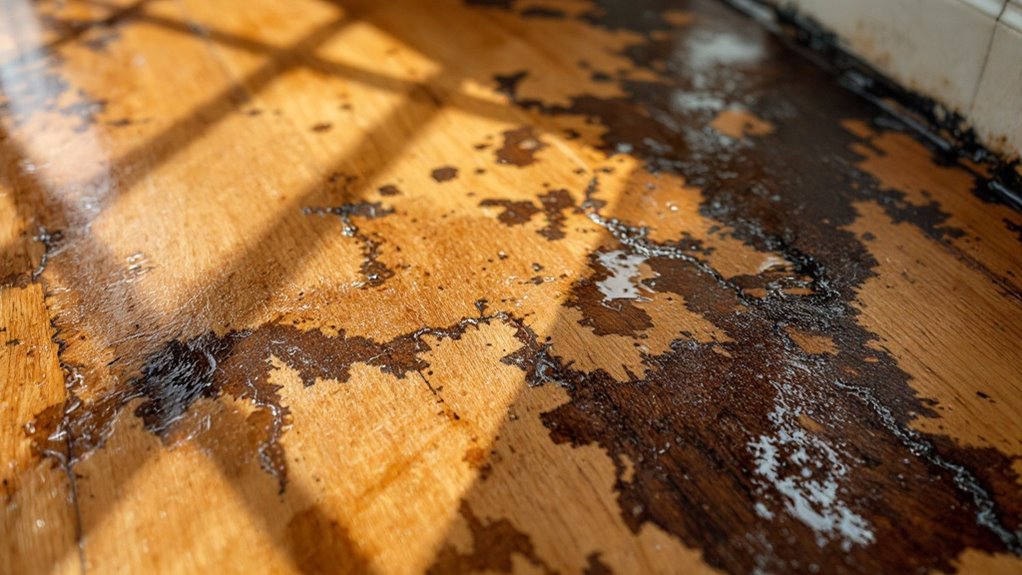Did you know that nearly 14,000 people in the U.S. experience a water damage emergency each day? If you’ve faced a leak, you’re likely weighing your options on whether to replace your floors. It’s vital to assess the damage carefully, as not all leaks require such drastic measures. Understanding the signs of damage can help you make the right choice for your home. So, what should you look for?
Key Takeaways
- Assess the extent of water damage; visible warping or soft spots often indicate the need for replacement.
- Consider the flooring material; hardwood and carpet are more vulnerable to moisture damage than vinyl.
- Evaluate for mold growth, as extensive infestations may require professional intervention and replacement of affected flooring.
- Factor in the cost of repairs versus replacement; sometimes new flooring can enhance home value and aesthetics.
- Ensure long-term considerations, such as moisture resistance and maintenance, align with your lifestyle and budget when deciding.
Understanding Water Damage and Its Effects on Flooring

When water seeps into your home, it can wreak havoc on your flooring. You might notice warping, buckling, or still mold growth, all of which can compromise your floor’s integrity. It’s crucial to act quickly; the longer water lingers, the more damage it causes. Depending on the material, your floors might absorb moisture, leading to swelling and discoloration. Even though the surface looks fine, hidden water can lead to structural issues. You’ll want to assess the extent of the damage, as some flooring can be salvaged with proper drying and treatment, while others may need replacement. Understanding these effects helps you make knowledgeable choices about your flooring and guarantees a safer, healthier living environment. Additionally, professional restoration services can assist in evaluating the damage and determining whether your flooring can be saved or needs to be replaced.
Types of Flooring and Their Vulnerability to Water
Different types of flooring respond to water damage in various ways, making it important to understand their vulnerabilities. Here’s a quick overview of three common flooring types and how they react to water:
- Hardwood: While beautiful, hardwood can warp and swell when exposed to moisture, leading to potential damage.
- Carpet: Carpets absorb water easily, creating a breeding ground for mold and mildew if not dried promptly.
- Vinyl: Vinyl is more water-resistant than other options, but prolonged exposure can lead to peeling or curling edges.
Understanding these vulnerabilities can help you take proactive maintenance measures after a leak. Knowing these vulnerabilities helps you make educated choices about repairs or replacements after a leak. Always consider your flooring type when evaluating the impact of water damage.
Assessing the Severity of the Leak

To assess the severity of a leak, you need to identify the extent of the water damage in your space. Check for mold growth, as it can signal prolonged exposure to moisture. Furthermore, evaluate how the specific floor material has been impacted, since some are more vulnerable than others. Regular inspections for signs of water damage are essential to determine whether replacement is necessary.
Identify Water Damage Extent
While you might be enthusiastic to replace your floors after a leak, it’s crucial to first assess the extent of the water damage. Start by checking the following:
- Surface Damage: Look for visible signs of damage, such as warping or discoloration on the floorboards.
- Underlying Issues: Investigate if the water has seeped beneath the surface, potentially affecting subfloor materials or insulation.
- Duration of Exposure: Consider how long the water was present; longer exposure often leads to more significant damage.
Check for Mold Growth
After evaluating the visible damage, checking for mold growth is vital, especially since mold can develop quickly in damp environments. Start by inspecting areas near the leak for any signs of discoloration or a musty smell, which often indicate mold presence. Don’t forget to look under furniture or inside walls, where moisture might linger unnoticed. If you spot mold, it’s important to address it immediately, as it can pose health risks and worsen damage. You might need professional help to safely remove mold and assess if further repairs are necessary. Remember, even small leaks can lead to significant mold growth, so thorough inspection is key to maintaining a safe and healthy home environment.
Evaluate Floor Material Impact
Understanding the impact of the leak on your floor material is essential, as different types of flooring react differently to water exposure. Evaluating the severity of the leak will help you determine if replacement is necessary. Consider the following factors:
- Material Type: Wood and laminate are prone to warping, while tile and vinyl are more water-resistant.
- Duration of Exposure: The longer the flooring is exposed to moisture, the greater the potential for damage.
- Extent of Damage: Visible signs like swelling, discoloration, or mold indicate that replacement may be the best option.
Signs of Damage to Look For

When a leak occurs, it’s crucial to identify signs of damage early to prevent further issues. Start by inspecting your floors for any visible warping or buckling. If you notice discoloration, such as dark spots or stains, that’s a clear red flag. Pay attention to any musty odors, which can indicate mold growth beneath the surface. Check for soft or spongy areas, as this might suggest water has penetrated the material. Moreover, listen for any unusual sounds when walking on the floor; creaking or popping could signal structural damage. Finally, keep an eye out for peeling or bubbling finishes, which can indicate moisture trapped underneath. Addressing these signs promptly can save you from costly repairs down the road.
The Drying Process: What You Need to Know
As you tackle the aftermath of a leak, knowing how to effectively dry your floors is crucial to preventing further damage. Follow these steps to guarantee thorough drying:
- Remove Excess Water: Use a wet/dry vacuum or mop to eliminate standing water promptly. The quicker you act, the less chance for damage.
- Increase Airflow: Open windows and doors, and use fans or dehumidifiers to circulate air. This helps speed up the drying process and reduces moisture retention.
- Check for Hidden Moisture: Inspect baseboards, under carpets, and between floorboards. Use a moisture meter if necessary to confirm that everything is dry.
Mold and Mildew: Health Risks and Prevention
When dealing with leaks, it’s essential to be aware of the potential health risks posed by mold and mildew. These fungi can lead to respiratory issues and allergic reactions if left unchecked. By understanding effective prevention strategies, you can protect your home and your health.
Health Impact Awareness
Although you may focus on replacing floors after a leak, it’s crucial to recognize the potential health risks posed by mold and mildew. These stubborn fungi can develop quickly in damp environments, leading to serious health issues. Here are three key concerns to be aware of:
- Respiratory Problems: Mold spores can irritate your lungs, causing coughing, wheezing, and difficulty breathing, especially in individuals with asthma or allergies.
- Skin Irritations: Direct contact with mold can lead to rashes, itching, and other skin issues.
- Long-Term Effects: Prolonged exposure to mold can contribute to chronic health conditions, affecting your overall well-being.
Being aware of these risks can help you make knowledgeable choices about your home and health after a leak.
Effective Prevention Strategies
To effectively prevent mold and mildew after a leak, you need to act quickly and decisively. Start by evaluating the damage; remove any wet materials like carpeting or drywall within 24-48 hours. Dry out the area completely using fans and dehumidifiers, as moisture is mold’s best friend. Guarantee good ventilation by opening windows and doors. If there’s lingering moisture, consider using mold-resistant products for repairs. Regularly inspect areas prone to leaks, like bathrooms and basements, to catch issues early. Keep humidity levels below 50% in your home using air conditioners or dehumidifiers. Finally, clean and maintain gutters and downspouts to prevent water from pooling near your foundation. Taking these steps can greatly reduce your risk of mold and mildew.
Cost Analysis: Repair vs. Replacement
While you might be tempted to patch up your floors after a leak, weighing the costs of repair versus replacement is essential. Consider these factors to help you decide:
- Extent of Damage: If the leak caused extensive damage, repairs might only be a temporary fix, leading to higher costs later.
- Material Costs: Evaluate the cost of materials for repairs versus replacement. Sometimes, replacing a floor can be more cost-effective in the long run, especially if it improves your home’s value.
- Labor Costs: Factor in the labor required for both options. Repairs may save money initially, but if they require frequent maintenance, replacement might be the wiser choice.
Making a knowledgeable choice now can save you money and hassle later.
Professional Assessment: When to Call in the Experts
If you notice signs of extensive damage after a leak, it might be time to call in the experts. Mold and mildew can pose serious health risks, and evaluating the structural integrity of your home is essential. Don’t hesitate to seek professional help to guarantee your space is safe and sound.
Signs of Extensive Damage
Noticing a few signs of damage after a leak can be concerning, but when you see extensive issues, it’s time to contemplate a professional assessment. Here are three key indicators that suggest you should call in the experts:
- Warping or Buckling: If your flooring is visibly warped or buckling, it’s a sign that the damage may be deeper than surface-level.
- Persistent Wetness: If areas remain damp in spite of drying efforts, there may be ongoing water intrusion that needs addressing.
- Cracking or Splitting: Any cracks or splits in your flooring can indicate structural damage, which requires immediate attention.
Ignoring these signs can lead to more significant problems down the line, so don’t hesitate to seek professional help when necessary.
Mold and Mildew Concerns
As water sits in your home, mold and mildew can quickly become a serious concern. These fungi thrive in damp environments and can develop within 24 to 48 hours after a leak. You might notice a musty smell, discoloration on walls or floors, or even respiratory issues in your family. If you suspect mold, it’s essential to act fast. While minor spots can sometimes be cleaned with appropriate solutions, extensive growth requires professional help. Experts can assess the situation, determine the extent of the infestation, and safely remove contaminated materials. Don’t underestimate the risks; mold can lead to health problems and further damage your home. When in doubt, call in the experts for a thorough evaluation.
Structural Integrity Assessment
When water damage occurs, evaluating the structural integrity of your home is crucial to guarantee safety and prevent further issues. You might be wondering when to call in the experts for an assessment. Here are three key signs:
- Visible Damage: If you see cracks in walls or ceilings, or if floors are sagging, it’s time to consult a professional.
- Persistent Moisture: Ongoing dampness or water pooling indicates that structural materials may be compromised.
- Unusual Sounds: If you hear creaking or popping noises, it could mean that your structure is under stress.
Don’t hesitate to seek help. A professional assessment can provide peace of mind and make certain your home remains safe and sound.
Long-Term Considerations for Your Home
While replacing floors after a leak can seem like a straightforward task, it’s crucial to contemplate the long-term implications for your home. Consider how the new flooring will impact your property’s value and aesthetic appeal. Will it complement your existing decor and meet your lifestyle needs? Think about durability; some materials resist moisture better than others, which can save you from future headaches. Moreover, factor in maintenance requirements—certain floors demand more upkeep, which could affect your budget over time. Finally, reflect on potential future leaks. Choosing the right flooring can minimize damage and simplify repairs if issues arise again, making your home safer and more comfortable in the long run. Prioritize wisely for lasting benefits.
Tips for Preventing Future Water Damage
To prevent future water damage, it’s vital to address vulnerabilities in your home proactively. Here are three important tips to help you safeguard your space:
- Regularly Inspect Plumbing: Check for leaks in pipes, faucets, and appliances. Fix any issues immediately to avoid water buildup.
- Maintain Gutters and Downspouts: Clean gutters regularly to guarantee proper drainage. Make sure downspouts direct water away from your foundation.
- Install a Sump Pump: Consider adding a sump pump in your basement. This can help manage excess water during heavy rains or floods.
Conclusion
In the end, deciding whether to replace your floors after a leak is like choosing between a band-aid and a fresh start. If you spot signs of damage, don’t let it fester like a wound; act swiftly. Weigh the costs and benefits, and remember, your home deserves a strong foundation to weather any storm. With the right choice, you can turn this setback into an opportunity, transforming your space into a safe haven once more.
